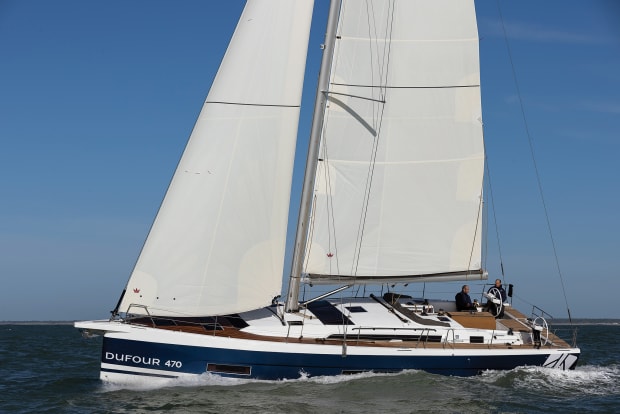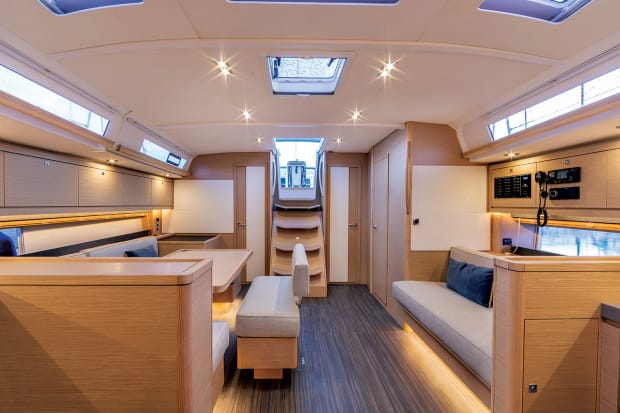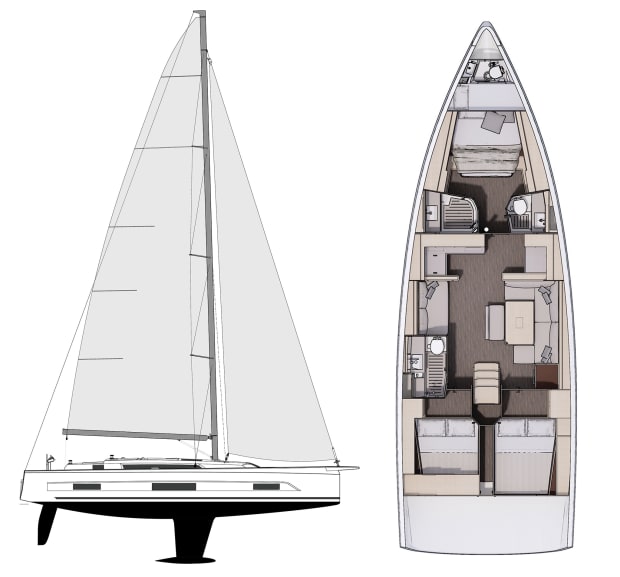
Annapolis may be the sailing capital of America, but if you looked around the United States Sailboat Show last fall, you would have no choice but to conclude most sailboats are now built in Europe. The Dufour 470 is a good example of a modern French performance cruiser.
DESIGN & CONSTRUCTION
The Dufour 470 carries the long waterline, hard chines, nearly flush deck and broad stern that have become commonplace of late aboard European boats. Particularly arresting is the chine that runs the entire length of the hull immediately below the sheerline and the slight tumblehome it provides up at the bow, presumably to help lower the center of gravity by reducing weight well above the waterline. Elongated hull windows and a second chine a short distance above the waterline further accentuate the perceived length of the boat’s topside. To my eye, the combination of these features in this new Umberto Felci design is rather handsome.
All Dufour boats are built at a single factory in La Rochelle, France, which in turn allows the company to control its entire supply chain in the interest of cost and quality control. I found the fit and finish of the 470 to be above average for a production boat, with the same emphasis on top-quality interior design and joinerywork that has been a trademark of the builder for many years.
The hull is infused with PVC foam coring above the waterline. The cored deck is also vacuum infused. The glass work that I could see in hidden places was neatly finished, with the component parts all fitted together carefully and accurately. The laminate schedule includes a vinylester outer layer to help stave off osmosis.
The wiring of the distributed electrical system and the hoses for the plumbing were all neat, bundled and labeled. Interiors lockers were all lined. Engine access under the companionway steps and from the sides is good.
As with many European boats, the deep draft-keel on the Dufour 470 could cause problems for those American sailors who typically sail the many shallower locales along the Eastern Seaboard. Granted, a deep, efficient keel enhances performance to windward. But it could also pose a challenge should you ever decide to go cruising or try and set the hook anywhere with 7ft of water or less. This includes many of the coves along the Chesapeake Bay, Intracoastal Waterway, Florida, Gulf Coast and the Bahamas. The rudder stock for the boat’s single, high-aspect rudder is solid stainless steel.
ON DECK
The Dufour 470 deck is all about living outdoors in comfort. The transom, for example, lowers to become the biggest stern platform I’ve ever seen on a boat this size, creating a sort of after-aft deck that will be especially useful for boarding since the freeboard of the boat is quite high.
All Dufours now have an outdoor galley at the stern, and the one on the 470 sports a real sink, counter space and a gas stove that will serve as a standard stovetop or a grill. You can put on your cookout apron with the silly slogan on it and whip up a complete meal here without creating any kind of mess or heating things up belowdecks.
Forward of the transom, a lot of thought from actual sailors went into the working part of the deck plan. The transition from the cockpit to the side decks, for example, is wonderfully easy, and each of the boat’s twin wheels has an excellent footrest for steering and covered bins to either side for tucking away excess sheet tails. Windage is minimal with good sightlines forward and plenty of room to grind winches and tail sheets, making the boat a joy to sail.
Dufour offers three versions of the deck layout, with a variety of choices in terms of winch placement and type, the mainsheet configuration, headsail size, which includes the option of a self-tacking jib. The short bow platform will accommodate an asymmetric light-air sail and doubles as an anchor roller to keep the hook away from the boat’s plumb bow. The owner of our test boat had specified a mast shortened by 4ft in order to clear the bridges on the Atlantic Intracoastal Waterway.

ACCOMMODATIONS
Moving down the well-designed companionway steps, I was greeted by what Dufour calls “Layout 4,” in which a transverse galley is set amidships across the forward end of the saloon. In this configuration, there are bulkheads to brace against in a seaway and ample countertops that do not intrude into the dining and seating areas. The other three interior choices feature a galley set along the boat’s starboard side.
On our test boat, seating for six surrounded a table to starboard. A series of large and small lockers surround the cabin, each with a secure door to provide excellent stowage. A television rises from within a bulkhead for comfortable viewing. While the interior panels are Alpi, an engineered wood laminate, the trim around the edges is solid wood. Our test boat had an attractive light oak color finish.
Light floods the interior through a set of big side windows and overhead hatches to create a pleasant, spacious look. The hatches are all equipped with shades, and the windows are tinted. Although there are no overhead handrails, the edges of the counters and bulkheads offer secure places to grip. Tall sailors will appreciate the high overhead clearance. The semi-freestanding forward berth is at a convenient height and allows good access from the sides. Two conventional double cabins aft complete the sleeping arrangements.
UNDER SAIL
The short mast’s reduced sail area aboard our test boat was just right for the 12 to 15-knot southerly breeze seas of a foot or less that greeted us out on Chesapeake Bay. The only headsail aboard was the self-tacking jib, which made handling easy but left us somewhat underpowered on occasion. The standard overlapping jib or a genoa and a full-size mainsail would obviously perk things up a bit in light to medium air. Off the wind, an A-sail or Code 0 would also be highly recommended.
Manual winches served the reduced sailplan we had and were more than adequate. However, I would recommend powered winches for anyone interested in going with the standard rig, as line loads will be higher. I found it a bit awkward cranking the coaming winches from the helm. However, they were just right for the rest of the crew. The cabintop traveler worked smoothly, making it that much easier to fine-tune the main.
Handling was perfect, with just enough helm feedback. The boat tracked steadily making it a pleasure to sail. I measured 6 knots of boatspeed on a close reach with tacking angles well under 90 degrees. Belowdecks, at speed, the Dufour 470 was exceptionally quiet, with nary a creak to be heard anywhere.
UNDER POWER
The Volvo saildrive pushed us along at a 6.7 knot pace at a 2,000 rpm cruise setting, accelerating to 8.4 knots with the throttle wide open at 2,750 rpm. At cruise, the sound level in the cabin was a low 66 dBA. Since cruising sailors motor more often than they care to admit, this quiet performance will be welcome. The turning response was quick, and the boat stopped and backed predictably. The turning circle was about 1.5 boatlengths.

CONCLUSION
The Dufour 470 hits a real sweet spots in terms of looks, handling and accommodations, with an exceptionally wide range of layout choices. The boat can be a cruiser, club racer or charter boat. It behaves well, moves efficiently and is quiet and comfortable. It is also well built and attractive, both inside and out. Whether in its details or as a complete package, the Dufour 470 is a nice sailing, good looking boat by any standard.
Specifications
LOA 48ft 8in LWL 44ft 6in BEAM 15ft 7in
DRAFT 7ft 5in
DISPLACEMENT 29,101lb
BALLAST 7,826lb
SAIL AREA 1,152ft2 (main and self-tacking headsail)
FUEL/WATER (GAL) 66/140
ENGINE 60hp Volvo diesel
SA/D Ratio 19 D/L Ratio 147
Ballast Ratio 27
What do these ratios mean? Visit sailmagazine.com/ratios
DESIGNER Felci Yachts
BUILDER Dufour, La Rochelle, France, dufour-yachts.com
PRICE $ 357,710 (base) at time of publication
July/August 2022








